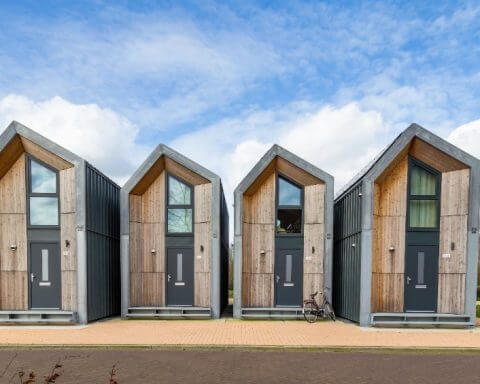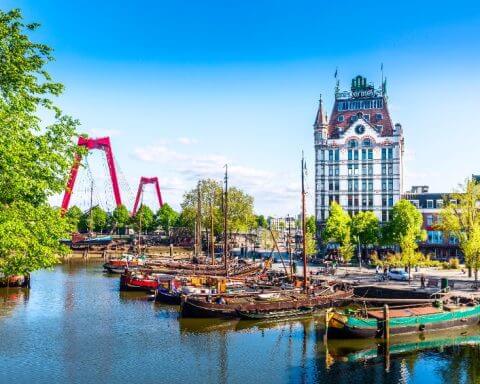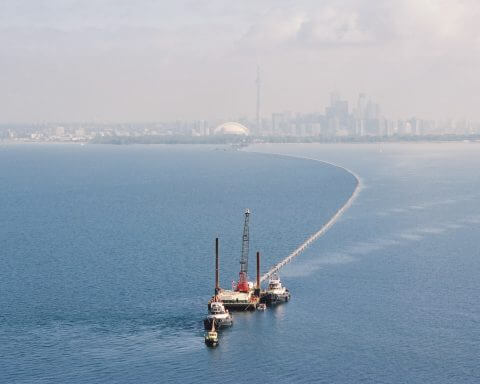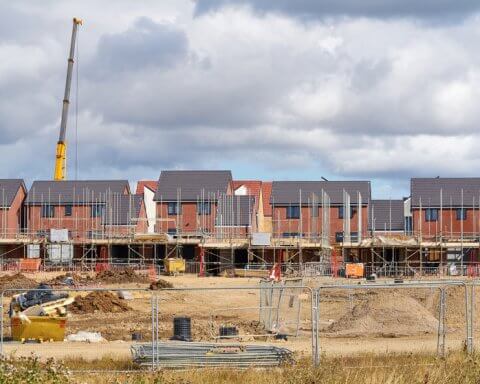Of the main carbon-emitting industries, experts say buildings and real estate should be one of the easiest to decarbonize. And yet the carbon emissions from buildings in Canada hit an all-time high in 2019, the most recent year for which data is available. Instead of declining, emissions from Canada’s building sector rose by 1.1 million tonnes that year. In order for Canada to deliver on its national climate targets, the building sector needs to ratchet down emissions by almost four million tonnes each year between now and 2030. This statistic should be setting off alarm bells in Ottawa, but instead the federal government is trying to put out the five-alarm blaze with a garden hose.
“We can’t keep trying to do retrofits in the way we were doing them in the 1980s and 1990s and expect to bend this curve,” said Ralph Torrie, head of research at Corporate Knights, at part four of our Earth Index event series tracking the “say–do” gap between Canada’s climate action and targets. Torrie estimates we will need to spend between $14 and $48 billion per year to achieve net-zero buildings by 2035, roughly on par with the $20 to $40 billion spent in Canada each year on routine maintenance and repairs.
“This cannot be our parents’ retrofit program,” Torrie said.
By 2030, existing Canadian homes will be responsible for 90% of residential emissions, so it won’t be enough to just ban gas hookups in new developments. Decarbonizing this sector will require an unprecedented scale of fuel switching to heat pumps and deep retrofit programs for existing buildings, he added.
Our general mindset has to change, panellists said. We have to stop thinking that the building industry’s emissions will gradually decline and realize that they must descend down a number of steep steps, said Akua Schatz, vice-president of market engagement and advocacy at the Canada Green Building Council. This will mean taking on an aggressive schedule of deep retrofits rather than depending on constant incremental ones. “You don’t have many chances. So every step matters,” Schatz said.
We also need to stop thinking of housing affordability and climate compatibility as opposing goals, said Steve Mennill, chief climate officer for Canada Mortgage and Housing Corporation, as deep retrofit programs will be central to bringing down the energy costs of the more than 2.8 million households in Canada that spend a disproportionate amount on energy, and sometimes have to choose between heating their homes and eating.
This has been particularly apparent in Heiltsuk First Nation in British Columbia, where leaders say an initiative to install heat pumps in homes has reduced residents’ heating costs and brought more energy sovereignty to the community. “It costs less to save a kilowatt than to generate one,” Leona Humchitt, a member of the Heiltsuk Tribal Council, told the panel. The community has installed heat pumps in more than 150 homes and hopes to complete retrofits in all 420 of its residential buildings.
Climate compatibility
Mennill pointed out that we need different solutions for retrofitting private rental housing, community housing and private homes. He said private rental housing needs greater access to capital, the community housing sector needs greater support through subsidy programs, and we need to look at ways to make these changes more affordable for homeowners. “Right now, your cost of capital as a homeowner, if you’re going to do a retrofit to your house, is basically the same [as] if you’re purchasing a new or existing non-climate-compatible house.”
Either way, when it comes to retrofitting multi-unit buildings, Mennil says both mitigation and adaptation need to be top of mind. “It’s not sufficient to consider just one or the other,” he told the panel. Reducing a building’s emissions needs to be done in lockstep with preparing it for the rising threat of floods and storms.
Barriers abound
One of the biggest and most obvious barriers to building owners taking on deep retrofits is asking them to pay for them out of pocket. “This needs to be a public service,” said Julia Langer, CEO of the Atmospheric Fund. Her organization is pushing for a fund to support these kinds of projects.
Building owners also simply don’t have the technical and financial expertise to carry out deep retrofit projects, which have lots of moving pieces. In an effort to help them navigate this process, the Atmospheric Fund has launched what it calls retrofit accelerators. “If you want to go deep in terms of retrofits, we need to ‘multi-solve.’ We can’t just look at the carbon,” Langer said. “We’ve got to look at social aspects, resilience, [and] financial aspects all together.”
In commercial real estate, Jamie Gray-Donald, senior vice-president of sustainability at QuadReal Property Group, said it will take more policy certainty from governments and much better data-gathering to rapidly decarbonize the sector. Gray-Donald said that the real estate sector is 20 years behind others when it comes to the type of data it has but that for every dollar invested in energy and carbon data, it’s possible to see a three- or fourfold return. “Once you have really granular stuff, amazing solutions open up,” he said.
Building innovation
While retrofitting existing buildings will make up the largest chunk of decarbonizing the real estate sector, research is underway to make constructing new developments carbon neutral. A Toronto-based start-up called Promise Robotics is working to use robotics and artificial intelligence to reduce the carbon footprint of building new homes.
And last year, Vancouver-based Nexii Building Solutions became Canada’s fastest company to reach “unicorn status” (when a start-up gains a value of $1 billion.) The company manufactures building panels made with a proprietary material called Nexiite, which it claims will reduce the building process’s carbon emissions by a third and cut energy demand to heat homes by 55%.
From an energy-source standpoint, Enwave has been working to install what’s called GeoExchange technology in thousands of new homes in North America. This system harnesses thermal energy from the ground to heat homes during the winter and cools air during the summer.
Catherine Thorn, a senior director of community energy planning at Enwave, noted another major hurdle to decarbonizing Canada’s buildings: builders are still being compensated with rebates for installing carbon-intensive natural gas infrastructure. Thorn said that if the developer isn’t planning to use natural gas, they’ll still be asked to install gas infrastructure and won’t receive any rebate if it isn’t used. “It’s a very big mismatch in incentive in what we’re trying to achieve,” she said.
Regulate and subsidize it
Governments across the world have varying records on their efforts to decarbonize buildings. The City of New York has upped its ambition on cutting building emissions, with a piece of legislation called Local Law 97. This bill will require most buildings with more than 25,000 square feet to meet standards on both energy efficiency and greenhouse gas emissions by 2024, and stricter limits will be enacted in 2030. Langer said Toronto is exploring the idea.
On the national level, some G7 countries have introduced robust retrofit subsidy programs. In 2020, the Italian government introduced a 110% subsidy for green retrofits that in turn boosted the country’s gross domestic product by 0.7% last year and created 153,000 jobs.
Canada, in contrast, has been a laggard in this area. The federal government’s modest retrofit program for homeowners that launched in May – the Canada Greener Homes Grant – has struggled to keep up with demand, having received more than 180,000 applications, according to The Globe and Mail. The program reimburses homeowners for up to $5,000 in retrofits and has processed payment to only 1,227 applicants as of January 18.
We can’t keep trying to do retrofits in the way we were doing them in the 1980s and 1990s and expect to bend this curve.
-Ralph Torrie, head of research at Corporate Knights
In December, the Prime Minister’s Office released mandate letters to cabinet ministers that signalled that retrofitting buildings would be part of the government’s plans to cut emissions, following similar commitments made during the recent election campaign.
Schatz said some of the key government commitments to watch in this area will be making the electricity system net-zero by 2035; implementing a national zero-emissions building strategy; creating a net-zero building code by 2024; and launching a National Infrastructure Assessment (an evolving document that will guide Canada’s infrastructure) that includes buildings.
The clock is ticking on the federal government’s pledge to axe emissions by 40% to 45% below 2005 levels by 2030. Since there are just over 400 weeks until that deadline, achieving this goal will involve taking a wrecking ball to Canada’s building emissions, and doing it swiftly.
“We’ve got to start behaving like this is the emergency we’ve been saying it is,” said Torrie. “We’re out of time.”







